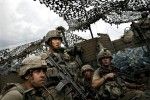Life in the Platoon: “Restrepo”

In the documentary film Restrepo, cinema-goers are treated to an intimate journey with a platoon of American soldiers in the Korengal Valley in Afghanistan. What sets Restrepo apart from other war documentaries, however, is there are no interviews with politicians, diplomats or families of the soldiers; there is no footage of anything other than the soldiers of the platoon. It is simply the soldiers and their experiences in, as Captain Kearney calls it in the film, “the deadliest place on Earth.”
The documentary was filmed over the 15-month deployment of the platoon. The audience is submerged deeply into their happenings, as filming was almost always only one man with a camera following the platoon everywhere – at their outposts, during meetings with town elders and even on dangerous operations under fire from the Taliban. Filmmakers Tim Hetherington and Sebastian Junger became essentially part of the platoon, experiencing the life of a soldier. As a result of this, the audience also experiences what the soldiers go through. Far away from their families, from political forces, from arguments concerning whether or not they even should be fighting, the only thing that matters to the soldiers in the Korengal Valley is survival. It is very reminiscent of last year’s Academy Award Best Picture winner The Hurt Locker with one big exception – it is all real.
This film viscerally conveys what these soldiers had to go through. These men, who are only 18 to 22 years-old, saw more action than most in either Afghanistan or Iraq do. Throughout the film, we see the losses they suffer, the emotional strain on being far away from home and their loved ones. The film excellently conveys the camaraderie that develops between the men of the platoon and the friendships that grow as they are united in their jobs, their mutual yearning for home and the losses they experience. As Captain Kearney says in an interview, “It’s really like a big family.” The name of the film comes from an outpost they built and named after a comrade that died early in the deployment, Juan “Doc” Restrepo. Deaths, such as Restrepo’s, stay with the soldiers far beyond their time spent in the Valley. Along with footage in the Korengal Valley, the film also includes interviews with the men after their deployment concluded. Through this, we see not only the emotional impact of memories from their deployment, but also the psychological impact.
“I’ve been on about four or five different type of sleeping pills and none of them help. That’s how bad the nightmares are. I prefer not to sleep and not dream about it than sleep and just see the picture in my head,” says Specialist Miguel Cortez in an interview after his time in Korengal Valley has concluded.
The filmmakers let us see how deeply affected these soldiers are, both during and after their time in action.
Shown as part of the P-CON Film and Lecture Series, Restrepo concluded with a Q & A with one of the directors of the film, Tim Hetherington. He spoke of his experience filming, his choice in film style, and the film’s impact: “I think more than ever what we need to do is to close the gulf between not just our thanks and gratitude to [the soldiers] but our understanding of what they’ve been through. So watching this film is, I hope, a constructive thing to understanding that reality because ultimately they have to come home and we have to make a place for them.”
He also spoke how they chose what to put in the film. He mentioned that the military did not censor them at all while filming and they were free to put whatever they wanted in the film.
“We’ve been pretty open-handed with what we chose,” he said. “We didn’t hide anything. We showed the good and the bad. We did it without a political agenda.”
This film, with its, at times, gritty camerawork and sound quality, gives the viewer a 90-minute experience of wartime that makes you feel as if you are there with the soldiers. The film achieves a deeply emotional journey with the platoon at Korengal Valley, through laughter with soldiers as they dance giddily to a pop tune, through longing for home as a soldier plays “I’ll Never Forget Where I’m From” on acoustic guitar and through heartbreak over friends lost in battle right before their eyes. It is an intimate portrait of war that young soldiers face every day overseas. Seeing Restrepo will give you emotion and intimacy to put with the many faces in the media of soldiers overseas.






